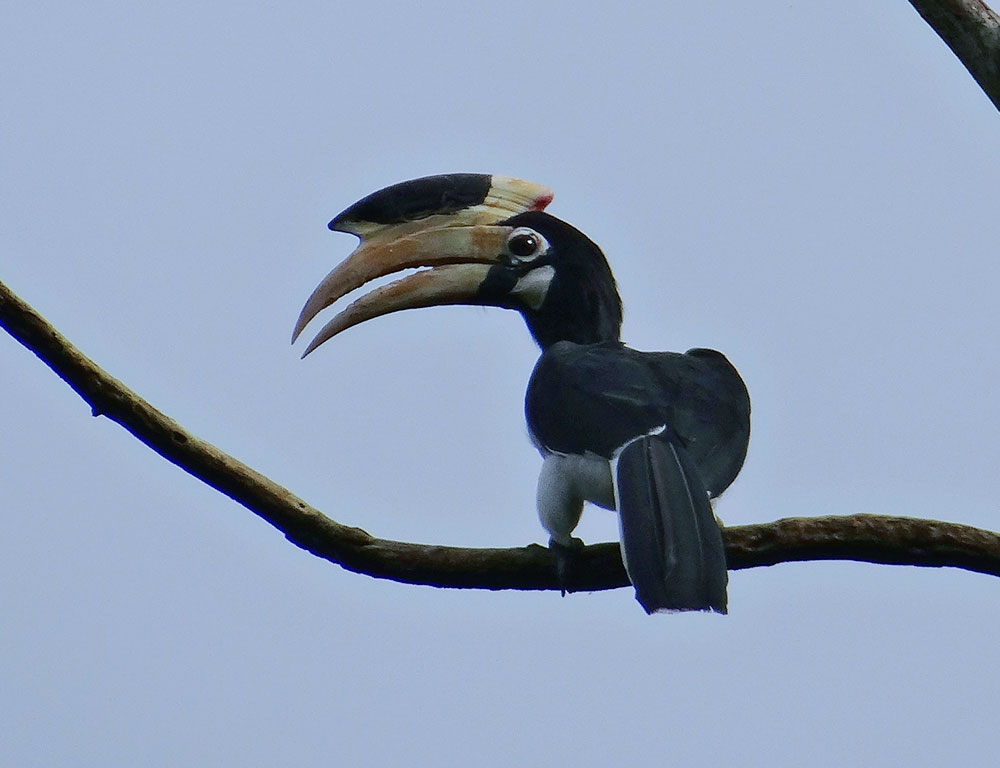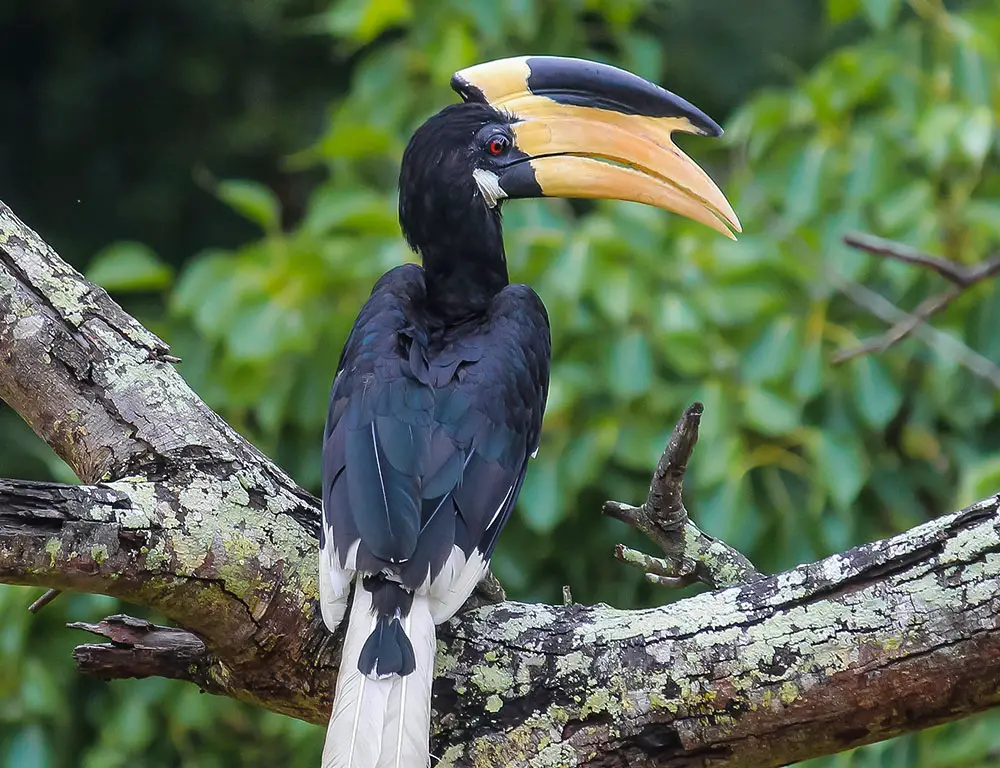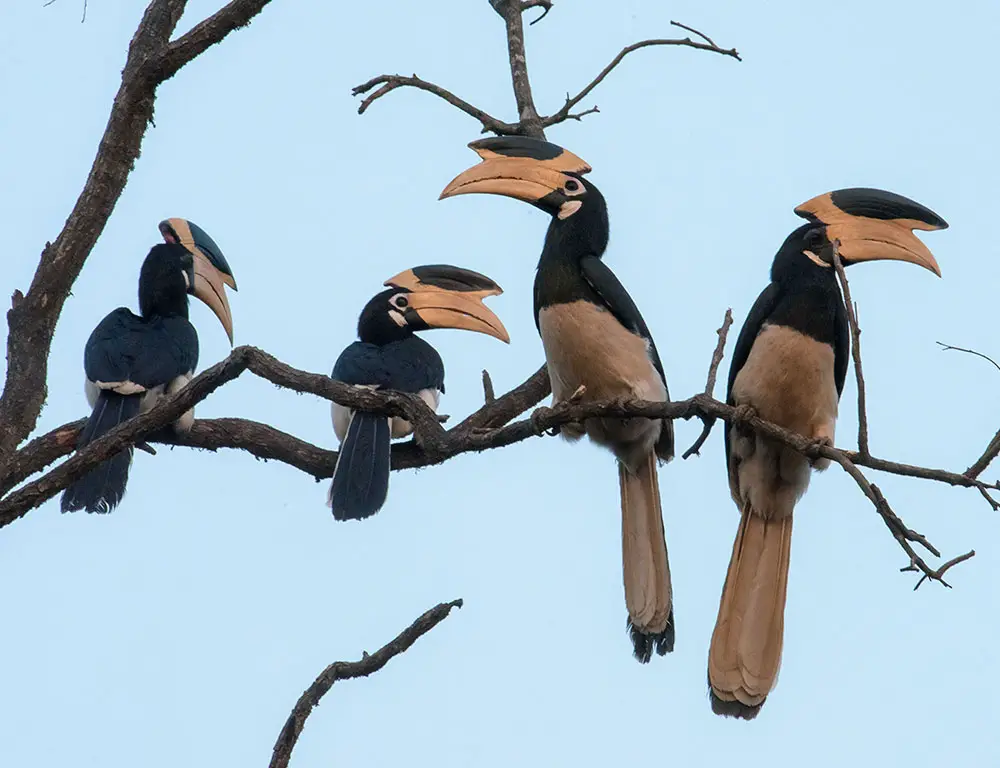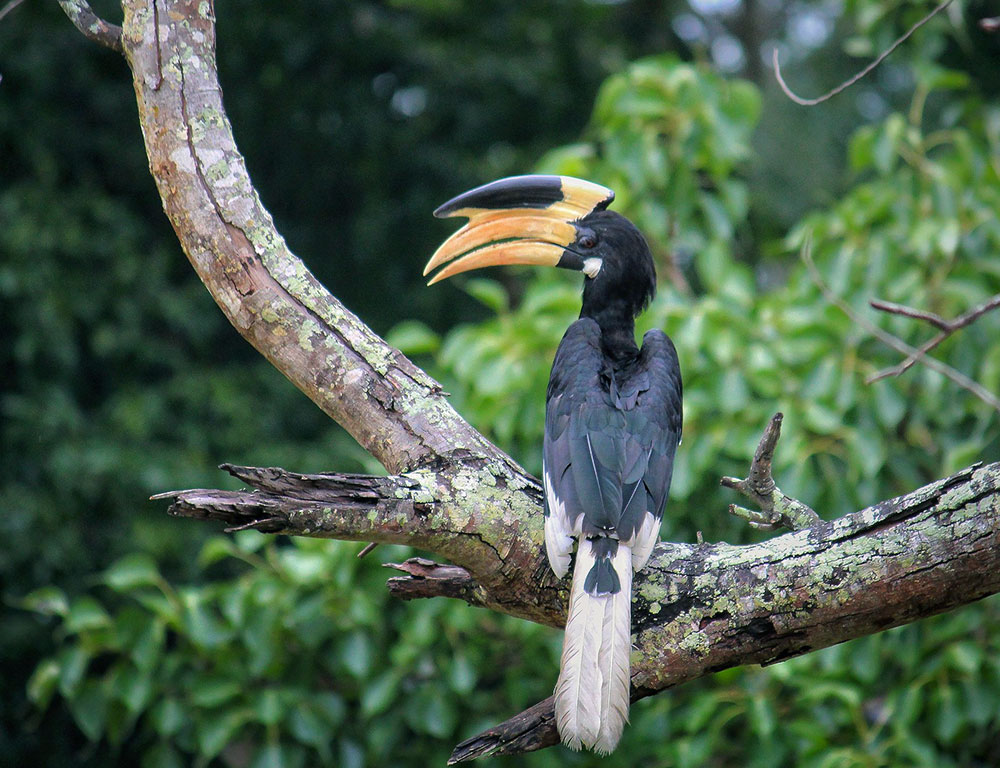I’ve always been fascinated by the diversity of bird species across our planet, and one that particularly catches my attention is the Malabar Pied Hornbill.
This remarkable creature hails from the Indian Subcontinent, making its home in the lush green forests of India and Sri Lanka.
A striking embodiment of nature’s beauty, this bird has become an emblem of biodiversity in these regions.
The Malabar Pied Hornbill boasts a distinct profile that differentiates it from other birds. It’s characterized by its large size, black-and-white plumage, and, most notably, its prominent yellow and black casque on top of its bill.
This unique feature isn’t just for show – it plays an integral role in amplifying sound waves to communicate with other hornbills.
However, despite their captivating appearance and intriguing behavior, the survival of Malabar Pied Hornbills is under threat due to habitat destruction.
Their plight underscores our responsibility as inhabitants of this Earth to safeguard nature’s wonders for generations to come.
Physical Characteristics of the Malabar Pied Hornbill

The Malabar Pied Hornbill, native to the Indian subcontinent, indeed possesses striking physical characteristics that distinguish it in the avian world.
Size and Weight
These hornbills are relatively large birds, with adults typically weighing between 1 to 2 kilograms (about 2.2 to 4.4 pounds). They stand at an impressive height of around 26 inches, making them taller than many domesticated animals like cats.
Sexual Dimorphism
There are notable differences between male and female Malabar Pied Hornbills. Females are generally smaller than males and have a distinctive white iris, contrasting with the red iris of males.
Plumage
Both sexes share a predominantly black and white plumage, which gives them their name. This plumage pattern adds to their visual appeal and aids in camouflage within their natural habitat.
Wingspan
Their wingspan ranges from 23 to 36 inches, making them quite a spectacle when they take flight. This impressive wingspan facilitates their aerial maneuvers and long-distance flights.
Beak and Casque
Perhaps the most striking feature of the Malabar Pied Hornbill is its vast, distinctive yellow and black casqued beak. This casque, along with the large beak, serves multiple purposes.
It aids in amplifying their calls, which are vital for communication within their social groups, and it also assists in handling and consuming various types of food.
Habitat and Distribution of the Malabar Pied Hornbill

The Malabar Pied Hornbill is a fascinating bird with a wide range of habitats and distribution across the Indian subcontinent and Southeast Asia.
Habitat Adaptability
These hornbills are remarkably adaptable, making their homes in various environments ranging from lush evergreen forests to deciduous woodlands. They also thrive in fruit plantations and areas with high rainfall, often near rivers and coastal belts.
Distribution in the Indian Subcontinent
The primary concentration of Malabar Pied Hornbills is in the Indian subcontinent, particularly in countries like India and Sri Lanka. Within India, they are commonly found in states such as Karnataka, Kerala, Goa, and Maharashtra.
Expansion to Southeast Asia
Beyond the Indian subcontinent, these birds also extend their range into Southeast Asia. Countries like Thailand and Myanmar are known to host populations of Malabar Pied Hornbills.
Habitat Description
Typical habitats where you might spot these hornbills feature tall trees with large diameters, crucial for nesting sites. They particularly favor areas with fig trees, as they serve as their primary food source.
Conservation Status
Despite their wide distribution range, Malabar Pied Hornbills are classified as Near Threatened by the IUCN Red List due to habitat loss and hunting pressure.
Conservation efforts are essential to preserve their habitats so future generations can appreciate these incredible birds.
Behavior and Diet of the Malabar Pied Hornbill

The behavior and diet of the Malabar Pied Hornbill indeed showcase their remarkable adaptability and intriguing characteristics:
Social Behavior
Malabar Pied Hornbills are known for their social nature, often seen in pairs or small family groups. They communicate with each other using distinctive calls and body signals, which are crucial for maintaining group cohesion and territory defense.
Breeding Behavior
Their breeding behavior is particularly fascinating. The female seals herself into a tree hole with mud during the nesting period, leaving only a tiny slit through which the male feeds her and the chicks. This unique strategy helps protect the vulnerable nestlings from predators.
Dietary Preferences
The diet of Malabar Pied Hornbills is quite diverse. Their primary food source is fruits, with figs being a favorite. However, they also consume insects and small reptiles opportunistically. This eclectic palate reflects their adaptability to varying food availability in their habitats.
Seed Dispersal
As seed dispersers, Malabar Pied Hornbills play a vital role in forest ecology. After consuming fruits, they excrete the seeds at new locations, contributing to the regeneration of plant populations and maintaining ecosystem diversity.
Feeding Habits
While they can drink water directly through their beaks like most birds, Malabar Pied Hornbills have been observed dunking food before eating it, almost as if washing it. This behavior might help soften or clean the food items before consumption.
Geophagy
Another interesting behavior observed in Malabar Pied Hornbills is “geophagy,” the practice of eating soil or earth. Scientists believe this behavior may aid in detoxifying plant toxins in their fruity diet, showcasing their remarkable environmental adaptations.
Conservation Status of the Malabar Pied Hornbill

The conservation status of the Malabar Pied Hornbill indeed presents a significant concern, with the species listed as “Near Threatened” on the International Union for Conservation of Nature (IUCN) Red List.
Several factors contribute to this status, primarily driven by human activities:
Habitat Loss
The expansion of human settlements, deforestation for agriculture, and logging activities are major threats to the natural habitats of Malabar Pied Hornbills. Loss of suitable habitat fragments populations and reduces available resources.
Hunting Pressure
The hornbills are also susceptible to hunting, primarily for their meat and casques. This further reduces their populations and disrupts their ecological roles within their habitats.
Population Decline
Population estimates indicate a decline over the years. From an estimated population of 10,000-19,999 birds in 1998, the numbers decreased to fewer than 10,000 mature individuals by 2012, highlighting the urgency of conservation efforts.
Efforts to mitigate these threats and conserve the Malabar Pied Hornbill are underway:
Protected Areas
The Indian government has initiated measures to protect hornbill habitats by establishing protected areas. These areas provide sanctuaries where the birds can thrive undisturbed.
Community-based Conservation
Non-governmental organizations like the Nature Conservation Foundation (NCF) have implemented community-based conservation programs.
These initiatives involve local communities in habitat restoration, monitoring, and awareness-raising efforts, fostering a sense of stewardship among residents.
Artificial Nest Boxes
Research into artificial nest boxes has shown promise in increasing breeding success rates. Conservationists aim to support the reproduction and survival of hornbill populations by providing additional nesting sites
Here’s a snapshot of some recent statistics:
| Year | Population Estimate |
| 1998 | 10,000-19,999 birds |
| 2001 | Less than 10,000 birds |
| 2012 | Fewer than 10,000 individuals |
Conclusion
I’ve been immersed in the world of the Malabar Pied Hornbill, and it’s safe to say these birds are incredibly fascinating. Their distinct features and unique behaviors undeniably stand out in the avian kingdom.
What makes them truly remarkable is their integral role in maintaining ecological balance. They’re excellent seed dispersers, helping forests thrive by spreading seeds far and wide. And because they need large tracts of mature forest to survive, they also act as important indicators of forest health.
However, I can’t help but feel saddened by the plight these creatures face. Deforestation dramatically shrinks their habitats – a stark reality that’s hard to ignore. The survival of this species hangs in a delicate balance, dependent on human actions.
| Status | Number |
|---|---|
| Population (2019) | 10,000-19,999 individuals |
| Decrease Rate Per Year | Approximately 2% |
- Decreased range due to habitat loss
- Hunting for beak trade
- Disturbance at nest sites
It’s not all doom and gloom, though! Concerted efforts are underway to safeguard this majestic bird from extinction. Conservation projects aim to preserve existing habitats while creating awareness about the importance of these birds among local communities.
In wrapping up my exploration of the Malabar Pied Hornbill, I hope you’ve found my insights enlightening — perhaps even inspiring enough to join me in advocating for their conservation. Remember: every bit counts when protecting our planet’s biodiversity!
The tale of the Malabar Pied Hornbill serves as a reminder that we need nature just as much as it needs us. Without such beautiful species gracing our ecosystems with their presence and contribution, our world would undoubtedly be less vibrant.